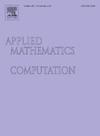用于多无人机编队飞行轨迹重新规划的容错模型预测滑动模式控制
IF 3.4
2区 数学
Q1 MATHEMATICS, APPLIED
引用次数: 0
摘要
为了解决具有高非线性和强耦合特点的多无人机(UAV)的轨迹跟踪问题,本文从方法论上将固定翼无人机的动力学分为两个子系统,并为每个环路设计了适当的控制器。与以往的研究不同,本文提出的多用途方法同时考虑了约束条件、计算时间、外部干扰和执行器故障。所提策略的包容性结构如下:首先,在外环中,通过利用非线性模型预测控制(NMPC)的高精度和约束处理特性,在考虑空间限制(包括禁飞区规避和车辆间碰撞规避)的情况下,引导代理的轨迹到达其参考位置。然后,设计内环的最佳状态。其次,在内环中,对容错滑模预测控制(SMPC)进行重新配置,以适应已识别的执行器故障,并遵循 NMPC 生成的最佳状态。通过一系列仿真结果,验证了所建议算法的有效性。比较仿真结果证明,建议的双环方法优于 NMPC 轨迹重新规划算法。本文章由计算机程序翻译,如有差异,请以英文原文为准。
Fault-tolerant model predictive sliding mode control for trajectory replanning of multi-UAV formation flight
To tackle the trajectory-following problem of multiple unmanned aerial vehicles (UAVs) characterized by high non-linearity and strong coupling, this paper methodologically separates the dynamics of fixed-wing UAVs into two subsystems and designs appropriate controllers for each loop. Unlike previous works, the proposed multi-purpose method simultaneously accounts for constraints, computational time, external disturbances, and actuator faults. The inclusive structure of the proposed strategy is as follows: Firstly, in the outer loop, by employing the high precision and constraint-handling attributes of nonlinear model predictive control (NMPC), the trajectories of the agents are guided to their reference positions while considering spatial limitations, including no-fly zone evasion and inter-vehicle collision evasion. Then, the optimal states of the inner loop are designed. Secondly, in the inner loop, a fault-tolerant sliding mode predictive control (SMPC) is reconfigured to accommodate identified actuator faults and follow the optimal states produced by NMPC. The effectiveness of the suggested algorithm is verified through a series of simulation results. Comparison simulation results substantiate the ascendancy of the suggested dual-loop method over the NMPC trajectory replanning algorithm.
求助全文
通过发布文献求助,成功后即可免费获取论文全文。
去求助
来源期刊
CiteScore
7.90
自引率
10.00%
发文量
755
审稿时长
36 days
期刊介绍:
Applied Mathematics and Computation addresses work at the interface between applied mathematics, numerical computation, and applications of systems – oriented ideas to the physical, biological, social, and behavioral sciences, and emphasizes papers of a computational nature focusing on new algorithms, their analysis and numerical results.
In addition to presenting research papers, Applied Mathematics and Computation publishes review articles and single–topics issues.

 求助内容:
求助内容: 应助结果提醒方式:
应助结果提醒方式:


